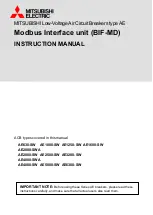
instrument transformers of a power line connecting two power subsystems. This is
shown in
.
-1.5
-1
-0.5
0
0.5
1
1.5
-1
-0.5
0
0.5
1
1.5
---------
-------
------
------
------
------
-------
-----
---
---
--
---
---
---
---
----
----
----
----
----
----
----
----
-----
-----
------
Real part (R) of Z in Ohms
Im
ag
ina
ry
pa
rt
(X
) o
f Z
in
O
hm
s
^ ^ ^ ^ ^ ^ ^ ^ ^ ^ ^ ^ ^ ^ ^ ^ ^ ^
--
--
--
-
-
-
-
-
-
-
-
-
-
-
-
-
-
-
-
-
-
--
--
--
-
--
--
--
-
-
-
-
-
-
-
-
-
-
-
-
-
-
-
-
-
-
--
--
--
-
0
1
Zone 1
Zone 2
The 1st
pole slip
occurred
relay
X in Ohms
The 2nd
pole slip
occurred
R in Ohms
RE
SE
2
3
to the 3rd
pole-slip
←
trajectory
of Z(R, X)
Pre-disturbance
normal load
Z(R, X)
0
→
pre-disturbance Z(R, X)
1
→
Z(R, X) under 3-phase fault
2
→
Z(R, X) when fault cleared
3
→
Z when pole-slip declared
lens determined
→
by the setting
StartAngle = 120°
limit of reach
→
IEC10000109-1-en.vsd
IEC10000109 V1 EN-US
Figure 61:
Loci of the complex impedance Z(R, X) for a typical case of
generator losing step after a short circuit that was not cleared fast
enough
Under typical, normal load conditions, when the protected generator supplies the
active and the reactive power to the power system, the complex impedance Z(R, X)
is in the 1st quadrant, point 0 in Figure
. One can see that under a three-phase
fault conditions, the centre of oscillation is at the point of fault, point 1, which is
logical, as all three voltages are zero or near zero at that point. Under the fault
conditions the generator accelerated and when the fault was finally cleared, the
complex impedance Z(R, X) jumped to the point 2. By that time, the generator has
already lost its step, Z(R, X) continues its way from the right-hand side to the left-
hand side, and the 1st pole-slip cannot be avoided. If the generator is not
immediately disconnected, it will continue pole-slipping — see Figure
, where
two pole-slips (two pole-slip cycles) are shown. Under out-of-step conditions, the
centre of oscillation is where the locus of the complex impedance Z(R, X) crosses
the (impedance) line connecting the points SE (Sending End), and RE (Receiving
End). The point on the SE – RE line where the trajectory of Z(R, X) crosses the
impedance line can change with time and is mainly a function of the internal
induced voltages at both ends of the equivalent two-machine system, that is, at
points SE and RE.
Measurement of the magnitude, direction and rate-of-change of load impedance
relative to a generator’s terminals provides a convenient and generally reliable
means of detecting whether machines are out-of-step and pole-slipping is taking
place. Measurement of the rotor (power) angle δ is important as well.
1MRK 506 382-UEN A
Section 6
Impedance protection
Line distance protection REL650 2.2 IEC
139
Technical manual
Содержание RELION 650 SERIES
Страница 1: ...RELION 650 SERIES Line distance protection REL650 Version 2 2 Technical manual ...
Страница 2: ......
Страница 46: ...40 ...
Страница 56: ...50 ...
Страница 164: ...158 ...
Страница 264: ...258 ...
Страница 304: ...298 ...
Страница 320: ...314 ...
Страница 338: ...332 ...
Страница 438: ...432 ...
Страница 468: ...462 ...
Страница 534: ...528 ...
Страница 646: ...640 ...
Страница 660: ...654 ...
Страница 676: ...670 ...
Страница 800: ...794 ...
Страница 836: ...830 ...
Страница 890: ...884 ...
Страница 894: ...888 ...
Страница 940: ...934 ...
Страница 941: ...935 ...
















































